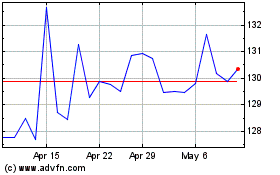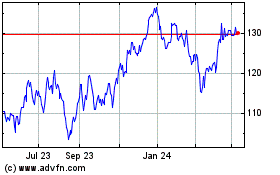Rio Tinto 2018 Iron Ore Shipments Up; Forecasts Further Rise This Year
January 17 2019 - 5:24PM
Dow Jones News
By Rhiannon Hoyle
SYDNEY--Rio Tinto PLC (RIO.AU) shipped more iron ore from its
Australian mining operations in 2018 as it increased output from
its newest mine and worked others harder, and forecast a further
rise in exports in the year ahead.
Rio Tinto, one of the world's biggest mining companies and top
exporters of steel ingredient iron ore, has continued to raise
output after a multiyear expansion, betting it can make strong
margins over the long run from a market it relies on for the bulk
of its earnings.
The miner said it shipped 338.2 million metric tons of iron ore
from its pits in the remote Pilbara region in northwest Australia
last year, up 2% on 2017. Exports were in line with an earlier
forecast from the company, which in October predicted shipments in
the upper end of a 330-340 million ton range.
Rio Tinto's iron-ore production was aided by an ongoing
productivity drive, good weather conditions and rising production
from its new Silvergrass mine, where it began mining in 2017. It
did face some disruptions during the third quarter from maintenance
work and the death of a truck operator at one of the company's
pits.
The miner said it expects a further rise in sales in 2019,
forecasting shipments from its Pilbara mines of between 338 and 350
million tons. Australia's Pilbara is the origin of more than half
the world's iron-ore trade by sea.
The company will next year start construction of a US$2.6
billion iron-ore mine that will be the miner's most high-tech
operation to date and buoy future production as older pits are
depleted.
Rio Tinto has spent billions of dollars expanding its vast
iron-ore mining network in a bet on continued strong demand for the
steelmaking commodity in Asia. To fatten profits from its biggest
division, the Anglo-Australian miner has also sought to make
existing mines more productive, including through the use of
autonomous equipment.
Rio Tinto typically earns a margin of more than 60% from its
iron ore business.
This month the company had to declare force majeure on some
iron-ore contracts after a fire at its Australian port
facilities.
A fire broke out at the Cape Lambert port in Western Australia
state on Jan. 10, causing damage to a section of the plant that
separates its Robe Valley lump and fine products.
Rio Tinto earlier this week said it would try to minimize
disruption to customers. It said setbacks because of the fire are
factored into its 2019 projections.
Rio Tinto on Tuesday also reported a 1% year-on-year fall in
output of bauxite, the raw ingredient in aluminum, despite recent
measures implemented to reduce bottlenecks at its Gove
operations.
Aluminum production fell by 3% on a year ago, while mined copper
output surged 33%. The jump in copper production reflected rising
output from all of its copper mines, particularly the large
Kennecott and Escondida operations.
Write to Rhiannon Hoyle at rhiannon.hoyle@wsj.com
(END) Dow Jones Newswires
January 17, 2019 17:09 ET (22:09 GMT)
Copyright (c) 2019 Dow Jones & Company, Inc.
Rio Tinto (ASX:RIO)
Historical Stock Chart
From Mar 2024 to Apr 2024

Rio Tinto (ASX:RIO)
Historical Stock Chart
From Apr 2023 to Apr 2024
